
JunOS_2_routingessentials
.pdf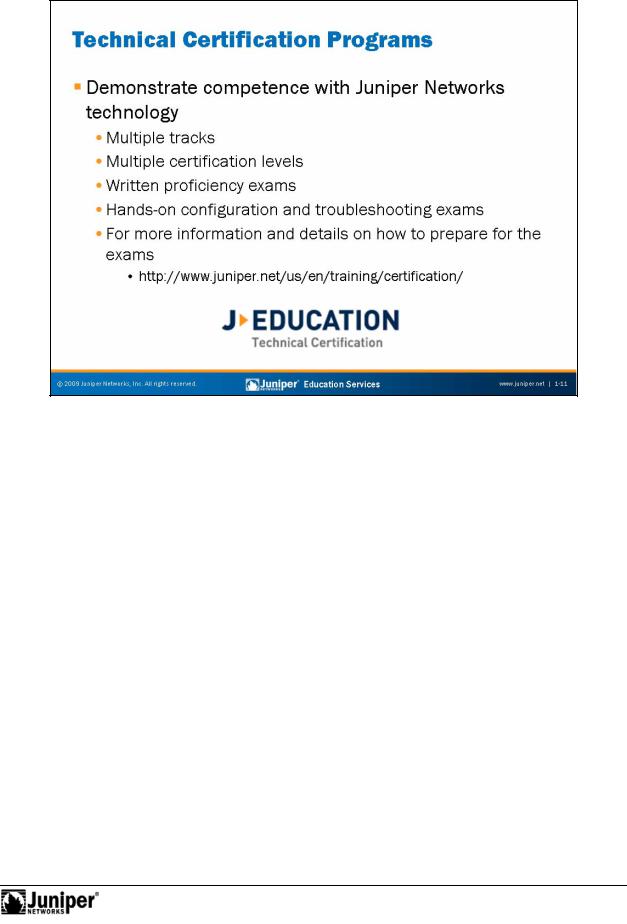
JUNOS Routing Essentials
The Juniper Networks Technical Certification Program (JNTCP) consists of forplatfo m-specific, multitiered tracks that enable participants to demonstrate, through a combination of written proficiency exams and handsconfiguration and
JNTCP Reproduction
tr ublesh ting exams, competence with Juniper Networks technology. Successful candidates demonstrate thorough understanding of Internet and security
Notechn l gies and Juniper Networks platform configuration and troubleshooting skills. You can learn more information about the JNTCP at
h p://www.juniper.net/training/certification/.
Course Introduction • Chapter 1–11
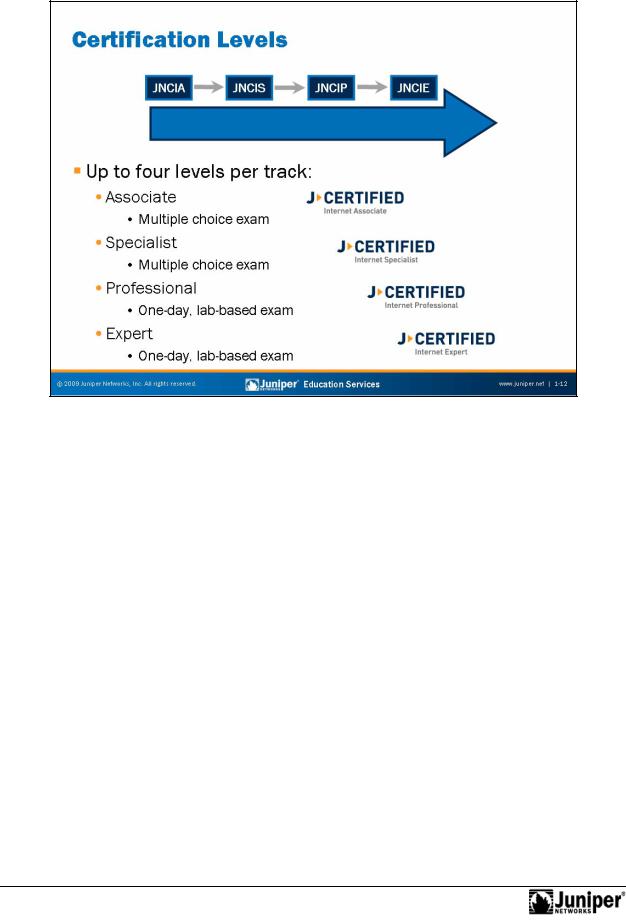
JUNOS Routing Essentials
Certification LevelsReproduction
Each JNTCP track has one to four certification levels. Associate-level and Specialist-level exams are computer-based exams composed of multiple choice questions.forThese computer-based exams ar administered at Prometric testing centers w rldwide and have no prerequisite certification requirements.
Professional-level and Expert-level exams are composed of hands-on lab exercises Notthat are administered at select Juniper Networks testing centers. Professional-level
and Expert-level exams require that you first obtain the next lower certification in the track. Please visit the JNTCP Web site at http://www.juniper.net/training/certification/ for detailed exam information, exam pricing, and exam registration.
Chapter 1–12 • Course Introduction
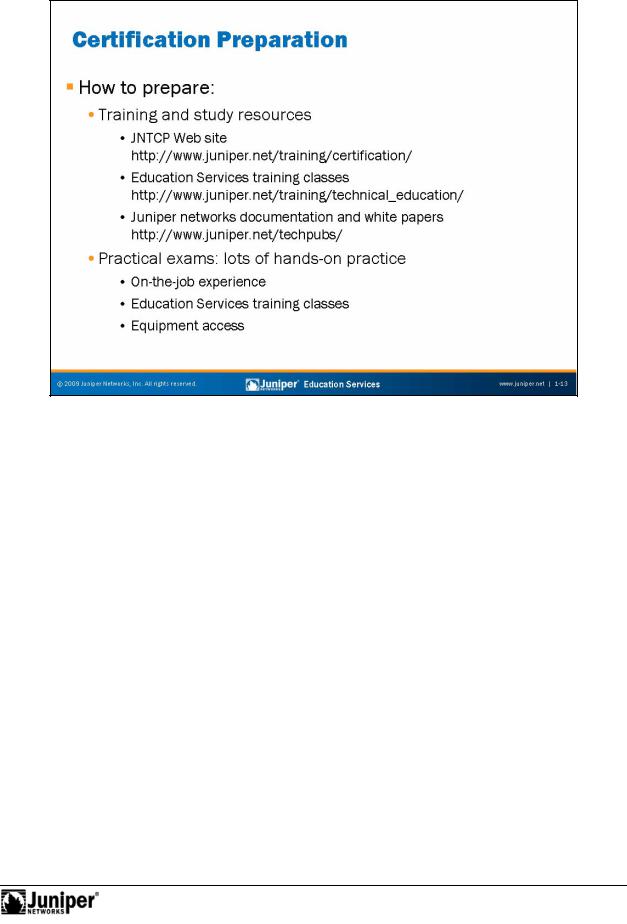
Not
JUNOS Routing Essentials
Prepping andReproductionStudying
This slide lists some options for those interested in prepping for Juniper Networks
certification. for
Course Introduction • Chapter 1–13

JUNOS Routing Essentials
Any Questions?
If you have any questions or concerns abou the class you are attending, we suggest |
||
that you voice them now so that your instructor can best address your needs during |
||
class. |
for |
Reproduction |
|
||
Not |
|
|
|
|
|
Chapter 1–14 • Course Introduction
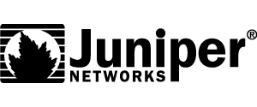
JUNOS Routing Essentials
Chapter 2: Routing Fundamentals |
||
|
for |
Reproduction |
Not |
|
|
|
|
|
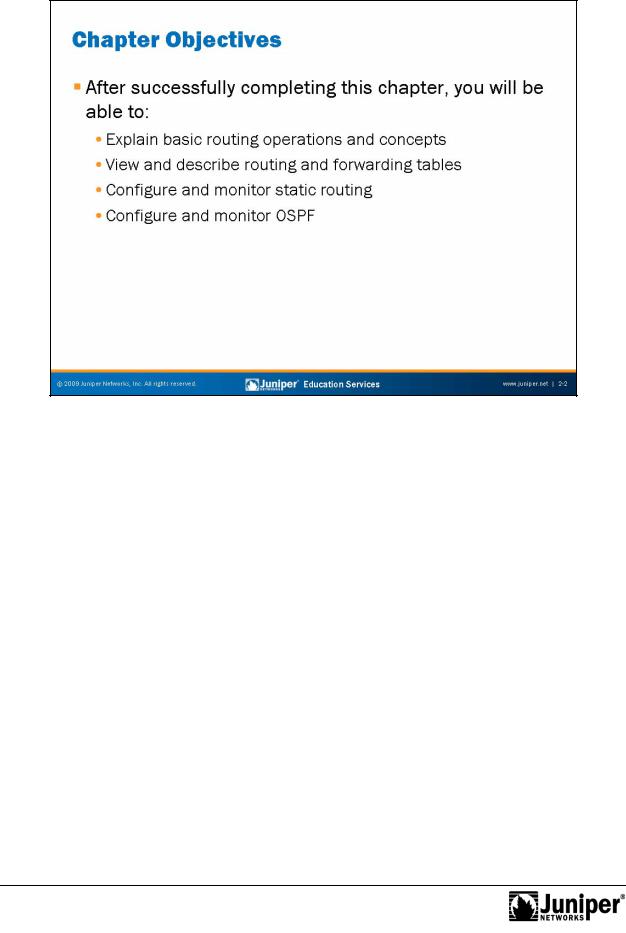
JUNOS Routing Essentials
• |
C nfigu ationReproductionand monitoring of static routing; and |
This Chapter Discuss s: |
|
• |
Basic routing operations and concepts; |
• |
Routing and forwarding tables; |
• |
for |
C nfiguration and monitoring of basic OSPF. |
|
Not |
|
Chapter 2–2 • Routing Fundamentals
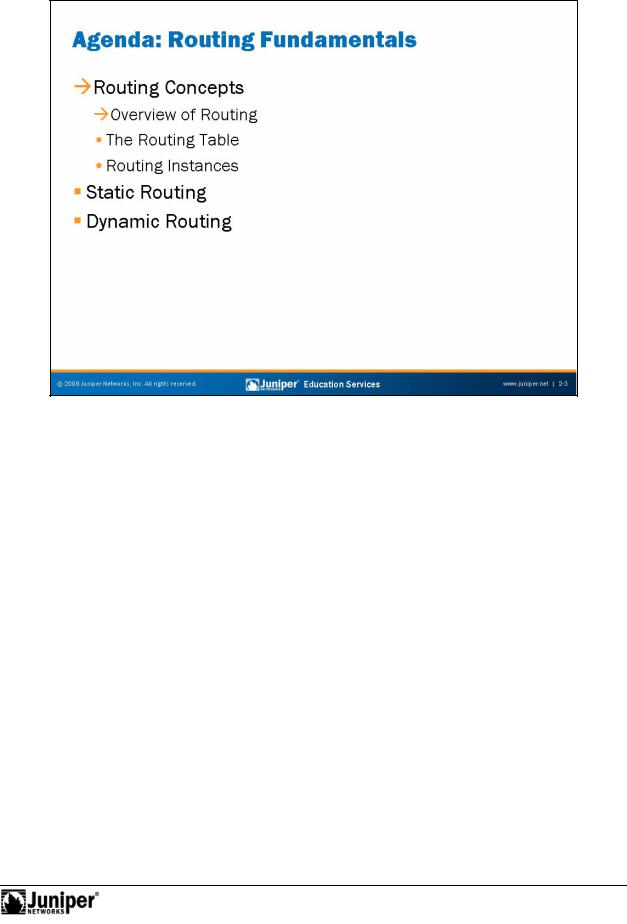
Not
JUNOS Routing Essentials
Routing ConcReproductionpts: Ov rview of Routing
The slide lists the topics we cover in this chapter. We discuss the highlighted topic
first. for
Routing Fundamentals • Chapter 2–3
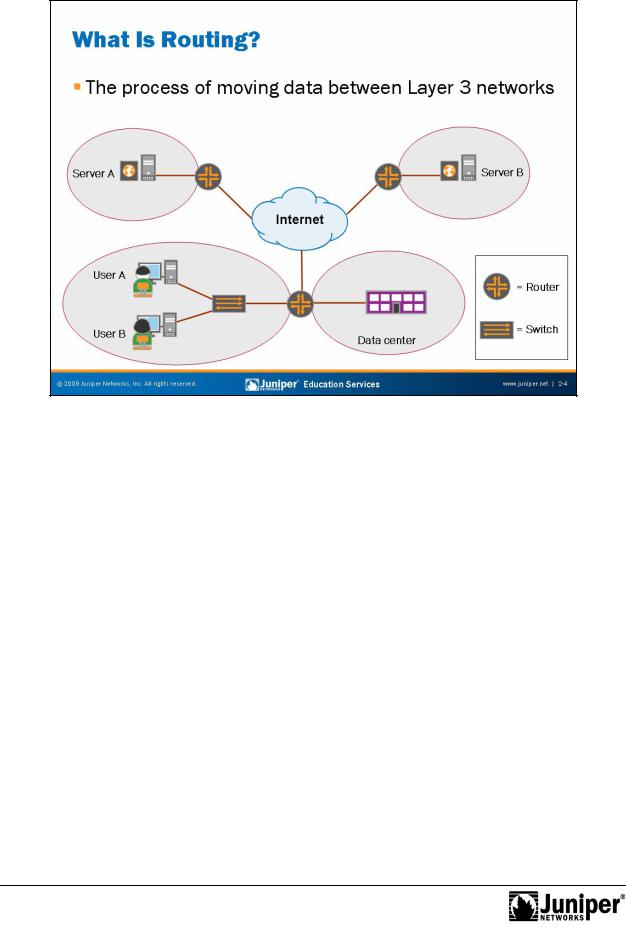
JUNOS Routing Essentials
A Basic Definition of Routing
Routing, in its most basicReproductionform, is the process of moving data between Layer 3 networks. The sample topology the slide consists of several Layer 3 networks, all
connectedforto oute s. Although routers are the most common devices for performing routing operati ns, note that many switches and security devices also perform routing operations. N te also that the Internet is actually a collection of many networks rather than a single netw rk.
NotWe l k at he required components of routing and how devices running JUNOS S ftware make routing decisions on subsequent slides within this section.
Chapter 2–4 • Routing Fundamentals
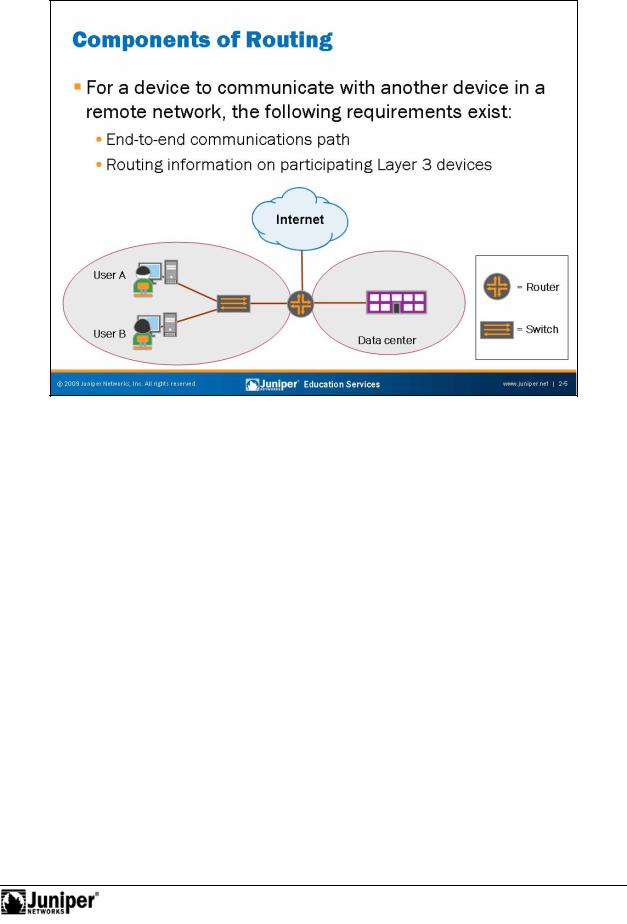
JUNOS Routing Essentials
Routing ComponReproductionnts
You must consider several components and other aspects to effectively implement routing between remote networks. However, you can classify the various components andforconside ations into two primary requirements—end-to-end communications path and ensu ing all Layer 3 devices within the communications path have the required r uting inf rmation.
NotIn he example shown on the slide, you can see that a physical path exists between he highlighted networks and the Internet. As long as the physical path is configured and functioning correctly, the first requirement is satisfied.
For the second requirement, all Layer 3 devices participating in the communications path must have the necessary routing information. The devices within the user and data center networks must have the proper gateway configured (the router that connects to those networks as well as the Internet). The gateway device must determine the proper next hop for each destination prefix for transit traffic it receives. Devices running JUNOS Software use the forwarding table, which is a subset of information found in the route table, to make this determination. We discuss the route and forwarding tables in the next section.
Routing Fundamentals • Chapter 2–5
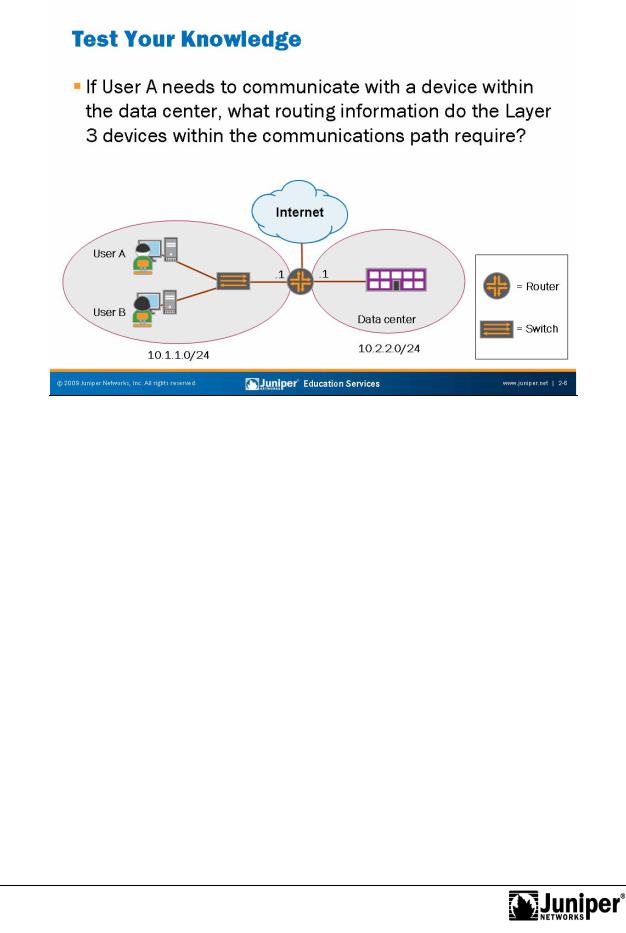
JUNOS Routing Essentials
|
|
|
Reproduction |
|
|
|
|
|
|
||
Test Your Knowledge |
|||||
The slide presents a simple routing scenar and asks what routing information is |
|||||
|
for |
||||
required |
User A to communicate with a device in the data center network. |
||||
For any device to communicate with another device outside its directly connected |
|||||
subnet, a pr |
pe ly c |
nfigured gateway is required. In the scenario illustrated on the |
|||
slide, the device ass |
ciated with User A must have its gateway set to the router’s IP |
||||
Not |
|
|
|
|
|
address (10.1.1.1). Likewise, the devices within the data center network need a |
|||||
pr perly configured gateway (10.2.2.1). |
|||||
The r |
uter, which functions as the gateway device for the user and data center |
||||
netw |
rks, requires sufficient routing information to determine the proper next hop for |
||||
the traffic sent between the connected networks. In this example, the router learns the required information by way of the interface configuration. The router adds the networks, in which the interfaces are participating, to the route and forwarding tables. The router consults its forwarding table to determine the actual next hop for received traffic.
Chapter 2–6 • Routing Fundamentals
